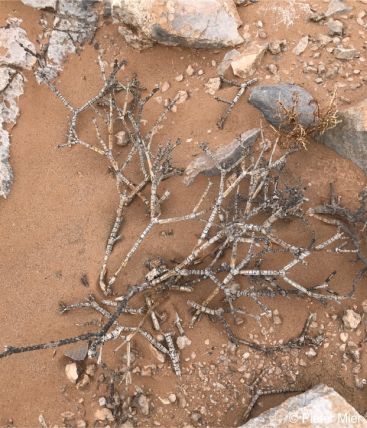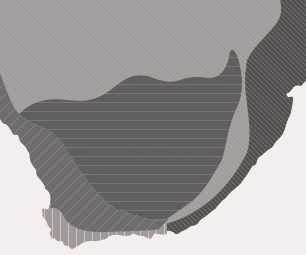Euphorbia rhombifolia
Euphorbia rhombifolia Boiss.
Family: Euphorbiaceae
Common names: springbuck milkbush (Eng.); springbokmelkbos, soetmelkbos, steenbokmelkbos, skaapmelkbos, kirriemoer, moerwortel, moerworteltjie, sikkiri, sikkiriwortel, bloumelkbos (Afr.)
Introduction
A highly variable species common in semi-arid vegetation in the western parts of South Africa and south-western parts of Namibia. Larger forms are typically found on stony slopes while smaller plants are found in gravelly areas with shallow soils. Yellow-green to green cyathia can be observed in winter and spring, between June and November, in winter rainfall areas. Euphorbia rhombifolia has the longest list of synonyms of all species of Euphorbia in southern Africa.

Fig. 1. Flowering shrubby variant of Euphorbia rhombifolia observed in the Northern Cape, South Africa.
Description
Description
A species displaying great variability, having plants differing in colour, size and shape. It is therefore quite difficult to characterize this species and often several forms will be found growing together. Plant height ranges from 30–60 mm. The larger forms are often hemi-spherical shrubs which can either be sparsely or densely branched. The smaller forms display even more diversity in shape, and may appear as dense, low-growing succulent plantlets or sparsely branched shrubs. Branches in the smaller variants may have hints of purple with a blue-green ring surrounding the nodes. A short, subterranean stem arising from a slightly tuberous taproot reveals sparse or dense branches above ground. Its branches are soft and succulent when young, becoming more rigid as the plant matures. The branches are without tubercles and may be erect, spreading or slightly flattened just below the node. The typical colour of plants of this species across most of its distribution is blue-green, however plants in the arid north-west may be yellow-green to bright green and may occasionally appear red. Triangular leaf rudiments grow in opposite pairs on the tips of young growth. These leaflets are small and swollen, with a hornlet on both sides at the base. They are initially green or reddish-green and later dry out and become small black husks in which their basal hornlets can still be seen.

Fig. 2. Close-up of succulent branches of the variant formerly known as E. chersina observed in Lüderitz, Namibia.
Many small cyathia form at the tips of branches, these are green in females and yellow-green in the males with males being produced in much larger quantities. The flowering time is in winter, spring and early summer, between June and November, in winter-rainfall regions and is rain dependent in the summer rainfall regions. Fruit in Euphorbia species is a capsule consisting of three locules with each locule containing a seed. It is obtusely three-angled and these capsule reach maturity within a month, once mature the seeds will be released through dehiscence of the capsules.

Fig. 3. Close-up of Euphorbia rhombifolia floral structure (cyathia). These are typically green in females and yellow-green in males.
This species resembles E. spartaria, E. tenax and E. muricata. Euphorbia rhombifolia can be distinguished from E. spartaria by its smaller habit and the slender, elliptic leaf rudiments in E. spartaria which lack the two hornlets at the bases, typical of E. rhombifolia. Euphorbia tenax and E. muricata both have these hornlets but E. tenax can be distinguished from E. rhombifolia by its more slender branches and rougher surfaces. Euphorbia muricata has much rougher branches than E. tenax and is much smaller, consisting of a few stout and vertically indented branches. The inflorescences of these species are difficult to separate.
Conservation Status
Status
Euphorbia rhombifolia is currently assessed as Least Concern (LC) on the Red List of South African Plants, because it is widespread and common. It has no severe threats although illegal collection for the specialist succulent trade and the ongoing droughts occurring in the northern parts of the country, and southern Namibia, may necessitate a status change soon.
Distribution and habitat
Distribution description
This species has a wide distribution extending from southern Namibia into South Africa. It is commonly found in the south-western parts of Namibia and the western parts of South Africa, which receive rainfall in winter, specifically in the karroid areas of the Cape Floristic Region and the Succulent Karoo region. It is also found in some summer-rainfall regions, where it has been recorded from Griqualand West across the Great Karoo to the arid parts of the Eastern Cape and the Free State.
Euphorbia rhombifolia is common in semi-arid vegetation in Namibia and South Africa, with the larger and often dense forms typically occurring on stony slopes or on hard loam in flat, gravelly places and seldomly found in looser sands. The smaller variants are typically found in flat, gravelly or stony spots with shallow soil as well as in low, sparge vegetation that is often surrounded by deeper soils and denser vegetation in steep areas.

Fig. 4. Dwarf variant of Euphorbia rhombifolia occurring in Gqeberha, Eastern Cape, South Africa.
Derivation of name and historical aspects
History
The genus name Euphorbia was assigned by Carl Linnaeus in the 18th century and is derived from the Greek name Euphorbus who was a physician to Numidian King Juba (II) who used the sap from Euphorbia species as medicine. The specific epithet rhombifolia describes the form of the leaf and can be interpreted as ‘with diamond-shaped leaves’ or ‘diamond-leaved’. The common name used for many euphorbias, spurge, is derived from the French word espurgier which means ‘to purge’ owing to the use of Euphorbia latex as a purgative. The South African name melkbos, meaning ‘milk bush’ refers to the white milky latex that the plants exude when damaged.
Euphorbia rhombifolia has been collected many times over the past two hundred years under different names, owing to its great variability. Various material of this species has been studied across various herbaria to determine the species involved in this complex. Now that its taxonomy has been resolved, it currently has the longest list of synonyms in southern Africa. The earliest collection of this species recorded in literature is undated and was collected by Francis Masson before March 1795. Two collectors from the Berlin Museum, J.L.L. Mund and L. Maire, made another collection in January 1820.
The genus Euphorbia has about 1 840 species and is one of the larger genera of flowering plants. It is the largest genus in the family Euphorbiaceae which has approximately 5 000 species. In southern Africa, 172 species of Euphorbia can be found, 128 of which are endemic to the region.

Fig. 5. Variant with purple-reddish branches and green rings surrounding the nodes, formerly known as E. indecora, occurring in the Western Cape, South Africa.
Ecology
Ecology
Euphorbia rhombifolia has unisexual, occasionally bisexual flowers but self-fertilization has been ruled out for most southern African species of Euphorbia. This is prevented by two mechanisms (1) male florets reaching maturity after the female florets, or (2) the female being borne on a long pedicle out of range as the male flowers mature and pollen becomes available. Pollination in Euphorbia species is an unspecialised process and once the cyathia has matured, a number of insects visit the plants over several days until the flowering period ends. Ten species of bee, beetle, fly and wasp were observed on E. rhombifolia in Goegap Nature Reserve by Struck in 2002, as referenced in Bruyns (2022). Pollinators are attracted either through scent or through nectar produced by the cyathial glands.
Seed dispersal in Euphorbia is through violent dehiscence, which results in the seed being ejected anywhere between 1–10 m from the parent plant. Buck species such as kudus and eland and other bigger mammal species may also aid in dispersal when the apices of shoots are ingested and later dumped large distances away from the parent plant. The caruncle (a small fleshy growth), present on seeds in some members, is attractive to ants and is another mechanism used for seed dispersal. The ants chew holes to release the carunculate seeds, which get stored in their burrows, where they will moisten and later germinate. Doves and other bird species may also assist with dispersal, breaking the capsules with their beaks, thereby releasing seeds.

Fig. 6. One of the biggest threats to Euphorbia rhombifolia is the ongoing drought experienced in both the Northern Cape (South Africa) and southern Namibia. Pictured is a E. rhombifolia specimen showing signs of drought-related mortality.
Uses
Use
Euphorbia rhombifolia is an important source of food for livestock and is heavily grazed in some areas, as is suggested by its Afrikaans common name, soetmelkbos which translates to ‘sweet milkbush’. The Afrikaans names moerwortel and kirriemoer indicate its use in fermentation for making bread and brewing of alcoholic beverages like beer. Horticulturally, cuttings of certain species such as E. tirucalli are planted closely together to form dense, impenetrable fences for demarcating properties, which could likely also be possible for the larger, denser varieties of this species.
Studies show that the sap of Euphorbia species possesses medicinal properties, with anti-inflammatory, anti-arthritic, antiviral, hepatoprotective and antitumor benefits. The sap of many species is traditionally used as an ingredient in arrow-poisons, for brewing beer, as bird-lime and there have been attempts to extract rubber commercially from certain species such as E. tirucalli and E. triangularis. These uses may also apply for the sap of E. rhombifolia.
Growing Euphorbia rhombifolia
Grow
Succulent species of Euphorbia are not challenging to grow, provided that they are kept within their habitat preferences. Species that occur naturally in the summer-rainfall areas grow actively when water is available between spring and autumn and rest during the cooler winter months, when they should be kept dry. Similarly, species occurring in winter-rainfall areas prefer water only in the winter months and should be kept dry in summer. Euphorbia rhombifolia is predominantly in the winter-rainfall regions, although some forms also fall within the summer-rainfall regions. To improve the likelihood of success in cultivation, the grower should find out in which region the form to be cultivated occurs.
Seed is the easiest method of propagation, but plants can also be propagated from cuttings. Euphorbia seeds can be collected by picking ripe fruit and storing the capsules in a cloth or brown paper bag and leaving these in a dry, warm place to dry out. When the seeds are ripe, the capsule will release them through dehiscence, the bag will catch the seeds as they are ejected from the capsule and they can be prepared and sown in a tray of seedling medium. To ensure optimum viability, seeds should not be stored for longer than two years and can be planted within a month after they are released.
A seedling mixture containing hydroponic peat/perlite/vermiculite (in the ratio 2:1:3 or 2:1:4) can be used to germinate seed. This mixture is well aerated, retains moisture well and does not become waterlogged. The seedling mixture can be added to fill 15 mm of the rim of the pot and then flattened. The seeds should be carefully laid out on the mixture and an additional 2-4 mm of the same mixture used to cover them. The mixture should be drenched overnight with water containing fungicide and moved to a shady, warm area the next morning. Watering can be repeated after a week or two to avoid the upper layers from drying out. Seeds will take approximately 14 days to germinate, followed by a period of rapid growth. Once several leaves have emerged, plants can be repotted into normal soil. Euphorbias prefer loamy soils.
Many species of Euphorbia can be easily propagated from cuttings, which involves cutting where the branch is constricted at the base and allowing the cutting to sit and dry for a period of 2-4 weeks. Once planted in well-drained loamy soil, it will soon begin to root. The cutting can be stabilized using stones, to prevent movement which might result in plant damage. The cutting should be watered frequently during this period.
Euphorbia rhombifolia can be grown outdoors as an ornamental plant, positioned in a sunny area, against a north-facing wall as is done with many of the larger species of Euphorbia. The larger forms can also be used to create barricades or barriers as mentioned under uses above.
Euphorbia plants are typically disease free. While insects can be a slight problem in habitat, in cultivation this can be prevented by treating plants with poison containing the active ingredient Imidacloprid. In cultivation, Euphorbia species are prone to infection by the red spider mite which leads to plant cell death, resulting in an unsightly brown colouration in plants. In habitat, some of the larger Euphorbia species are parasitized by other plants.
References
- Archer, R.H., Vlok, J.H., Victor, J.E. & Raimondo, D. 2017. Euphorbia rhombifolia Boiss. National Assessment: Red List of South African Plants. https://redlist.sanbi.org/species.php?species=574-311.
- Bruyns, P.V. 2022. Euphorbia in southern Africa: Volume 1. Springer International Publishing, Switzerland.
- Bruyns, P.V. 2022. Euphorbia in southern Africa: Volume 2. Springer International Publishing, Switzerland.
- Curtis-Scott, O., Goulding, M., Helme, N., McMaster, R., Privett, S. & Stirton, C. 2020. Field guide to the Renosterveld of the Overberg. Struik Nature, Cape Town.
- Ghout, A., Zellagui, A., Gherraf, N., Demirtas, I., Ayse Sahin, Y., Boukhenaf, M., Lahouel, M., Nieto, G. & Akkal, S. 2018. Antiproliferative and antioxidant activities of two extracts of the plant species Euphorbia dendroides L. Medicines 5(2): 36.
- Kemper, J. 2024. Observation of Euphorbia rhombifolia, Karas Region, southern Namibia. iNaturalist. https://www.inaturalist.org/observations/225995843.
- Kirsten, T. 2021. Observation of Euphorbia rhombifolia, Eden, Western Cape. iNaturalist. https://www.inaturalist.org/observations/94368710.
- Kruger, T. 2024. Observation of Euphorbia rhombifolia, Namakwa, Northern Cape. iNaturalist. https://www.inaturalist.org/observations/259743925.
- Mier, P. 2021. Observation of Euphorbia rhombifolia, NC, Northern Cape. iNaturalist. https://www.inaturalist.org/observations/93333602.
- Nichols, G. 2005. Growing rare plants: a practical handbook on propagating the threatened plants of southern Africa. Southern African Botanical Diversity Network Report No. 36.
- Ridge-Schnaufer, C. 2024. Observation of Euphorbia rhombifolia, Kruisrivier, Western Cape. iNaturalist. https://www.inaturalist.org/observations/257350758.
- Rusch, N. 2020. Controlled fermentation, honey, bees and alcohol: archaeological and ethnohistorical evidence from southern Africa. Southern African Humanities 33:1–33.
- Strydom, L. 2021. Observation of Euphorbia rhombifolia, Gqeberha, Eastern Cape. iNaturalist. https://www.inaturalist.org/observations/99344660.
Credits
Nokukhanya Mhlongo
Threatened Species Unit
July 2025
Acknowledgements: the author thanks Tristan Kruger, Christine Ridge-Schnaufer, Jessica Kemper, Luc Strydom, Tim Kirsten and Pieter Mier for making their images available via iNaturalist.
Plant Attributes:
Plant Type: Shrub
SA Distribution: Eastern Cape, Free State, Northern Cape, Western Cape
Soil type: Sandy, Loam
Flowering season: Spring, Early Summer, Winter
PH: Acid, Neutral
Flower colour: Green, Yellow
Aspect: Full Sun
Gardening skill: Easy
Special Features:
Horticultural zones








Rate this article
Article well written and informative
Rate this plant
Is this an interesting plant?
Login to add your Comment
Back to topNot registered yet? Click here to register.